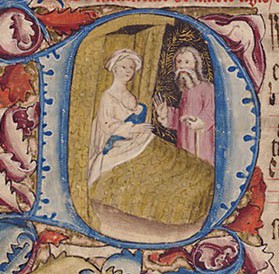
July 23, 2014, by Nicola Royan
‘þe best mylke is womman milke’: Does Breast Milk Heal? – Guest post by Erin Connelly
On a recent episode of GPs: Behind Closed Doors (Channel 5), a reality show that examines doctor-patient relationships, a young mother told her GP that she had been treating her infant’s conjunctivitis with breast milk. The GP was surprised by this treatment and advised against it, stating that it was both ineffective and unpleasant. However, the use of breast milk in medicine is an ancient remedy that is still widely practised in the present day. Even a cursory search of alternative medicine sites reveals a wide range of beliefs about the curative powers of breast milk – everything from curing minor infections to treating cancer. But where in history does this idea appear and is there any evidence-based support for it?
One medieval medical document, The Lylye of Medicyne, uses breast milk as a cure-all for multiple conditions. The Lylye is an important fifteenth-century Middle English translation of a Latin medical text, the Lilium Medicinae, which was completed in 1305 by Bernard of Gordon, a medical doctor and lecturer in Montpellier. The English manuscript (Ashmole 1505) is nearly 500 pages long and contains hundreds of treatments for diseases affecting both the body and mind. Out of nearly 6000 references to botanical and medicinal ingredients, milk, from both humans and animals, is the fourth most mentioned ingredient in the text.
In the Lylye, milk is consumed, applied externally, and used as a base agent for compound medicines. It is said to be curative in everything from fevers and swellings to warts, acne, toothaches, sore throat, epilepsy and wasting conditions. In the chapter dealing with a serious type of fever (Ethica), the text states: ‘þe best mylke þat is for hem is womman milke . . . As myche as it is possible, lete hymtake of a womman brestis’. Furthermore, milk (particularly breast milk) is praised as ‘mete and drinke and medicyne’ and even in the deadly wasting condition Ptysis (most likely pulmonary tuberculosis) breast milk is said to provide ‘grete helpe þeron’.
Although breast milk is used as a cure-all in the Lylye, much as it is in alternative practices today, the references to milk are heavily concentrated in the section dealing with disorders and diseases of the eyes. For instance, in the chapter on conjunctivitis, the text instructs the medieval doctor to ‘droppe ofte womman milke in his yȝen‘. So, returning to the young mother mentioned previously, is there any evidence to suggest that breast milk is effective in dealing with infections of the eyes?
One such study in the Journal of Tropical Pediatrics investigated the effects of human colostrum against conjunctivitis in newborns in developing countries. The study states: ‘our findings suggest that local instillation of human colostrum significantly reduces the incidence of sticky eyes and conjunctivitis’ and, furthermore, ‘the cultural practice of instilling colostrum into the eyes of newborn babies has a sound scientific basis, is desirable and needs to be encouraged’ (Singh, M, Sugathan, P., Bhujwala, R. ‘Human Colostrum for Prophylaxis Against Sticky Eyes and Conjunctivitis in the Newborn’ Journal of Tropical Pediatrics, 28, 1982, pp. 35-37). Another study sixteen years later in the Journal of Reproductive Immunologyalso investigated the antimicrobial effects of human colostrum in neonatal conjunctivitis. They obtained similar results to the first study and stated that all samples of colostrum ‘significantly inhibited chlamydial growth in a dose-response manner’ (Ramsey, K., Poulsen, C., Motiu, P. ‘The in vitro antimicrobial capacity of human colostrum against Chlamydia trachomatis’ Journal of Reproductive Immunology 38 (2), 1998, pp. 155-167).
Of course, these two studies deal specifically with colostrum applied to conjunctivitis of the neonate. However, they also demonstrate that there appears to be an effective antimicrobial agent in breast milk, which lends some explanation to why the practice has persisted for so many centuries.

Really interesting! Presumably the reference in the 1982 study to ‘the cultural practice of instilling colostrum …’ is directly referring to using breast milk directly. It’s easy to laugh at medieval medicine but there often seems to be some kind of sensible basis for much of it. Thanks for writing this.